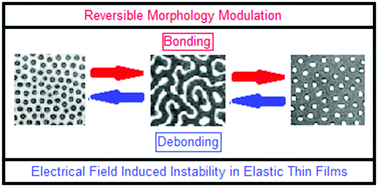Reversible morphological switching and deformation hysteresis in electric field mediated instability of thin elastic films†
Abstract
Reversible morphology switching in a soft elastic film sandwiched between two parallel electrodes when subject to an externally applied electric field is reported herein. In contrast to electric field mediated instability of a thin liquid film, where the instability patterns remain permanent, in the present case the patterns debond completely or partially when the electric field is switched off, depending on whether the gap spacing (dG) between the film and the top electrode is >100 nm or not. The onset of instability is marked with the appearance of isotropic columns when the applied field strength (U) exceeds a critical value (Uc). The subsequent increase in U leads to the gradual transition of the instability patterns from pillars to bi-continuous labyrinths to an array of holes. Complete conformal contact is established between the film and the top electrode at U = UF. When U is reduced, the morphology changes in a reverse sequence. There is a significant level of hysteresis between the bonding and debonding stages, including persistence of the features at much lower voltages due to pinning of the patterns to the top electrode. Complete detachment occurs at a lower voltage UD when dG > 100 nm. The holes fluctuate before complete contact between the film and the top electrode due to competition between the destabilizing electric field and restoring forces due to stretching of the crosslinked polymer matrix.



 Please wait while we load your content...
Please wait while we load your content...